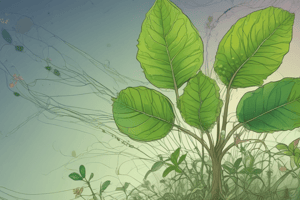Podcast
Questions and Answers
Which of the following is NOT a major plant tissue?
Which of the following is NOT a major plant tissue?
- Vascular tissue
- Ground tissue
- Meristematic tissue (correct)
- Epidermal tissue
Which of the following does photosynthesis convert into oxygen and sugars?
Which of the following does photosynthesis convert into oxygen and sugars?
- Water and sunlight
- Water and carbon dioxide (correct)
- Oxygen and carbon dioxide
- Sunlight and carbon dioxide
Which of the following is a characteristic of vascular plants?
Which of the following is a characteristic of vascular plants?
- They rely on locomotion for survival
- They have well-developed conducting and complicated tissues (correct)
- They lack stems, leaves, and roots
- They do not produce seeds
What is the function of meristematic tissue?
What is the function of meristematic tissue?
What are the internal structures of vascular plants responsible for?
What are the internal structures of vascular plants responsible for?
Flashcards are hidden until you start studying
Study Notes
Major Plant Tissues
- Major plant tissues include dermal, ground, and vascular tissues.
- Meristematic tissue is typically NOT classified as a major type of plant tissue.
Photosynthesis Process
- Photosynthesis converts carbon dioxide (CO2) and water (H2O) into glucose (sugars) and oxygen (O2).
- The process takes place in chloroplasts using sunlight as energy.
Characteristics of Vascular Plants
- Vascular plants possess specialized structures called xylem and phloem for transporting water, nutrients, and food.
- They exhibit true roots, stems, and leaves, differentiating them from non-vascular plants.
Function of Meristematic Tissue
- Meristematic tissue is responsible for the growth and development of new plant cells.
- It is found primarily at the tips of roots and shoots (apical meristems) and in lateral cambium.
Internal Structures of Vascular Plants
- Internal structures, such as xylem and phloem, facilitate the movement of water, minerals, and carbohydrates throughout the plant.
- These structures enable plants to support larger sizes and complex forms compared to non-vascular plants.
Studying That Suits You
Use AI to generate personalized quizzes and flashcards to suit your learning preferences.




